This buttery vegan brioche bread has a fluffy and tender crumb that melts in your mouth. It's made with only 7 simple pantry ingredients and is egg-free and dairy-free!
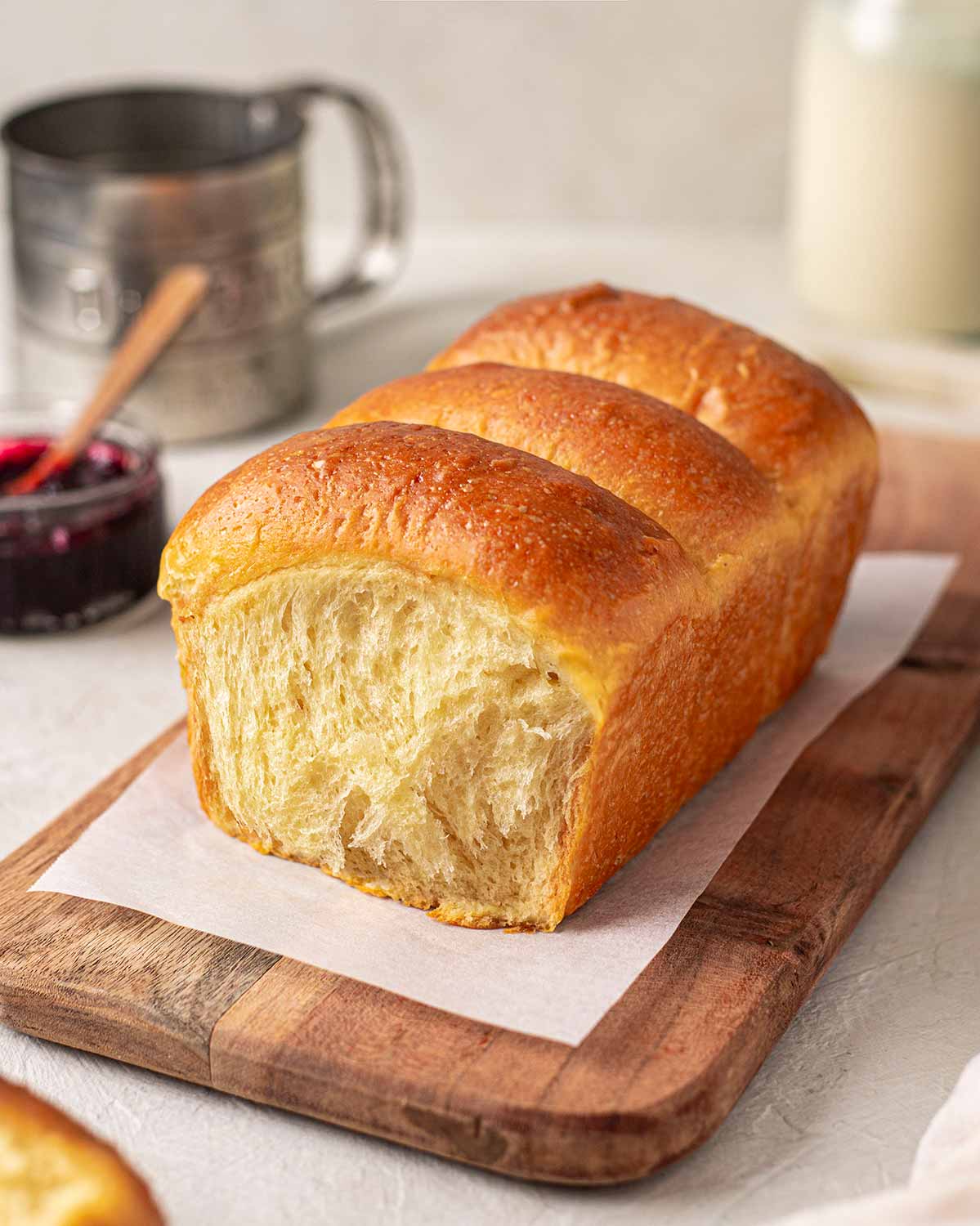
Table of contents
Simple ingredients you'll need
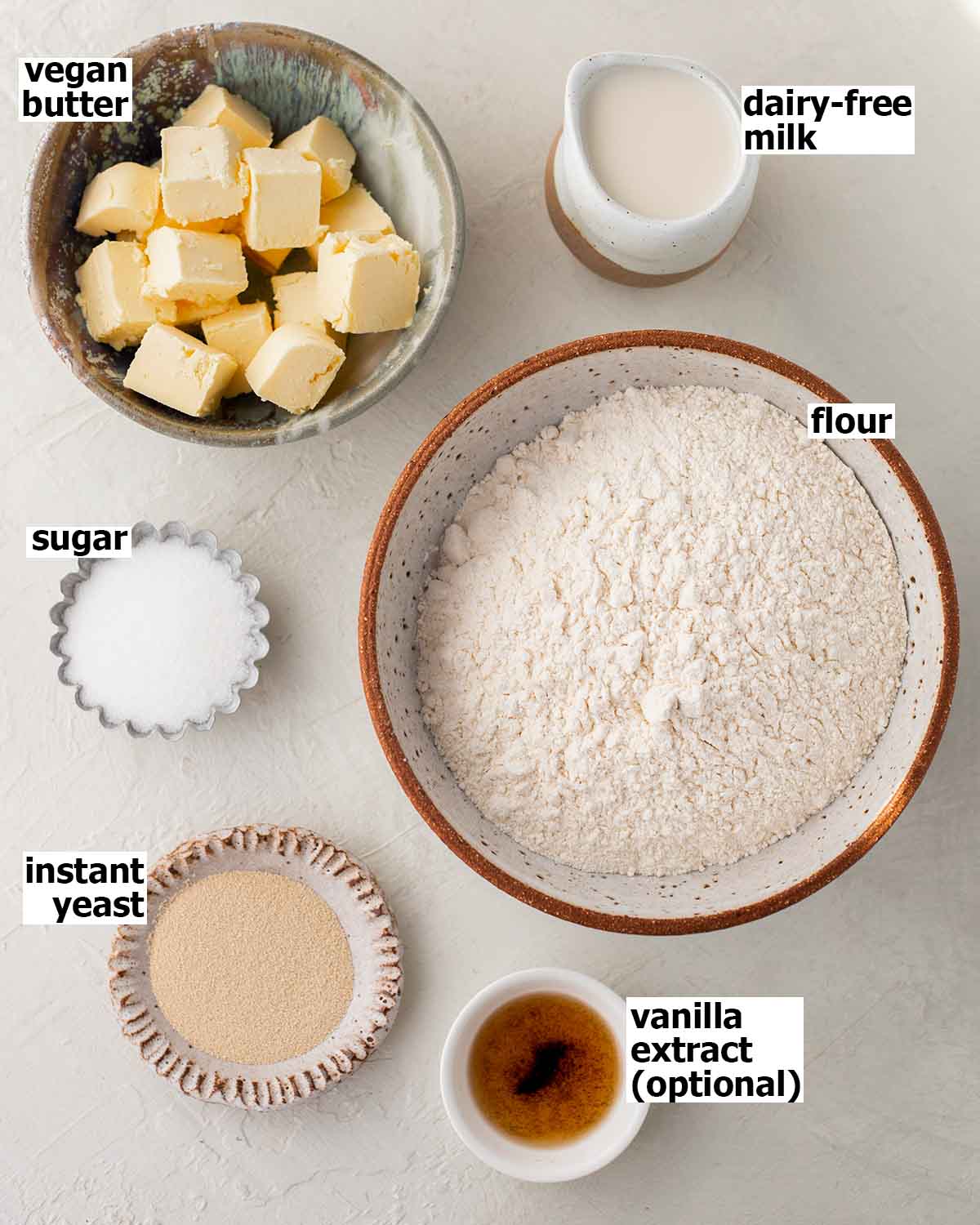
Notes about the ingredients
Bread flour or all-purpose plain flour. All-purpose flour creates a cakier vegan brioche whereas bread flour gives the brioche a slight 'chew'.
Vegan butter creates a rich and tender texture that's typical of traditional brioche and makes it different from sandwich bread.
Dairy-free milk. I prefer soy milk as it's higher protein and creates a richer brioche. However, any dairy-free milk will work.
Instant-dried yeast because it's easier and quicker to use than any other yeast. Or you can use dry or fresh yeast, as long as you proof it first.
Traditionally, French brioche bread is enriched with eggs or egg yolks. However, by increasing the amount of fat through butter and rising power through yeast, we can create an eggless and dairy-free brioche that is soft, fluffy and tender.
The full list of ingredient quantities and instructions are in the gray recipe card at the bottom of this post.
Two different kneading methods
You can knead the dough by hand or in a stand mixer. However, there are two different methods for kneading the dough.
- Easy method where you knead all the ingredients at the same time. This takes 5-10 minutes and makes a soft and buttery brioche. If you're kneading by hand, this is the best method for you (left picture).
- Traditional advanced method where you add the butter later on. This takes at least 20-30 minutes and makes the bread more feathery when you pull it apart (right picture).
For a step-by-step guide on both methods, watch the video earlier in this post.
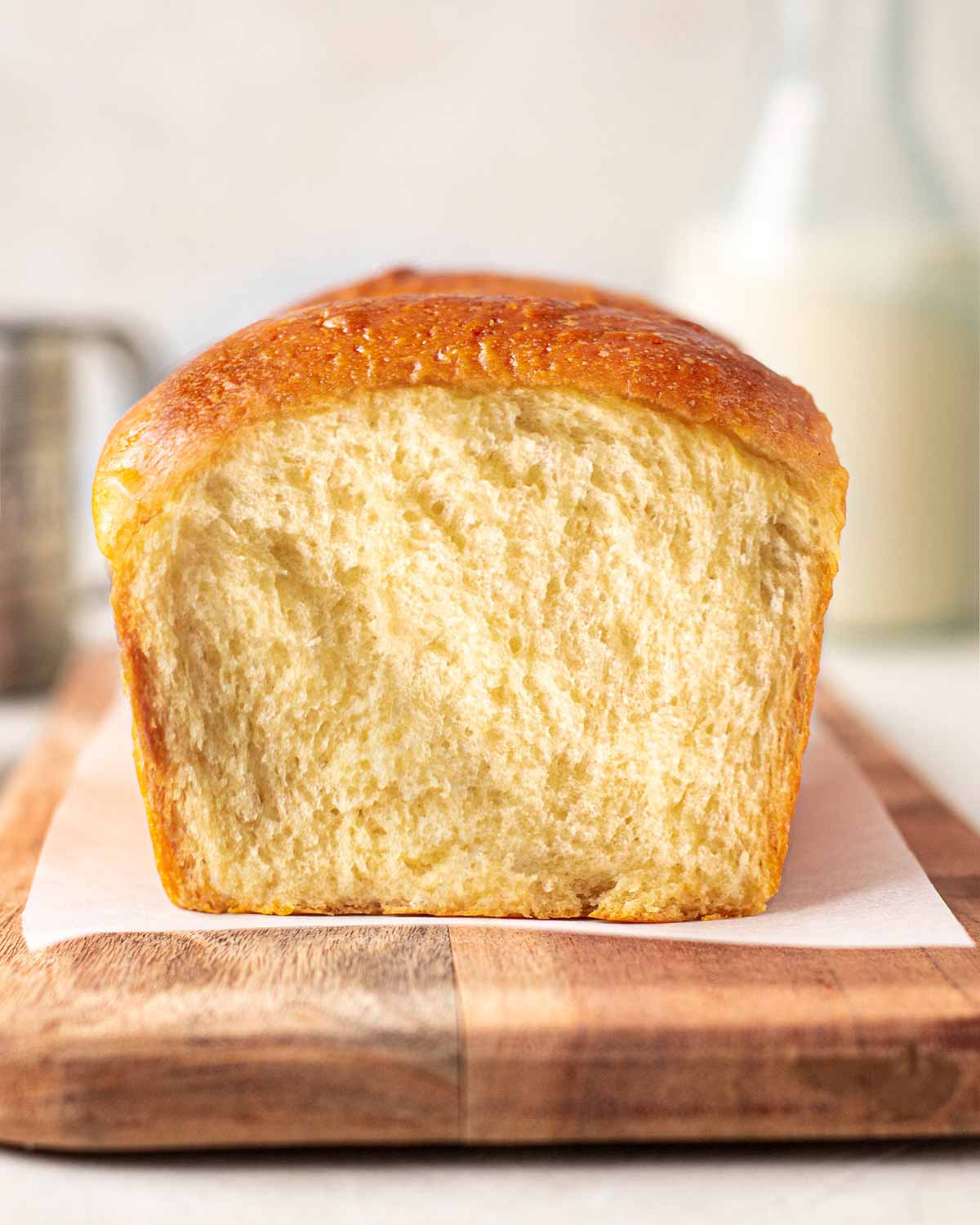
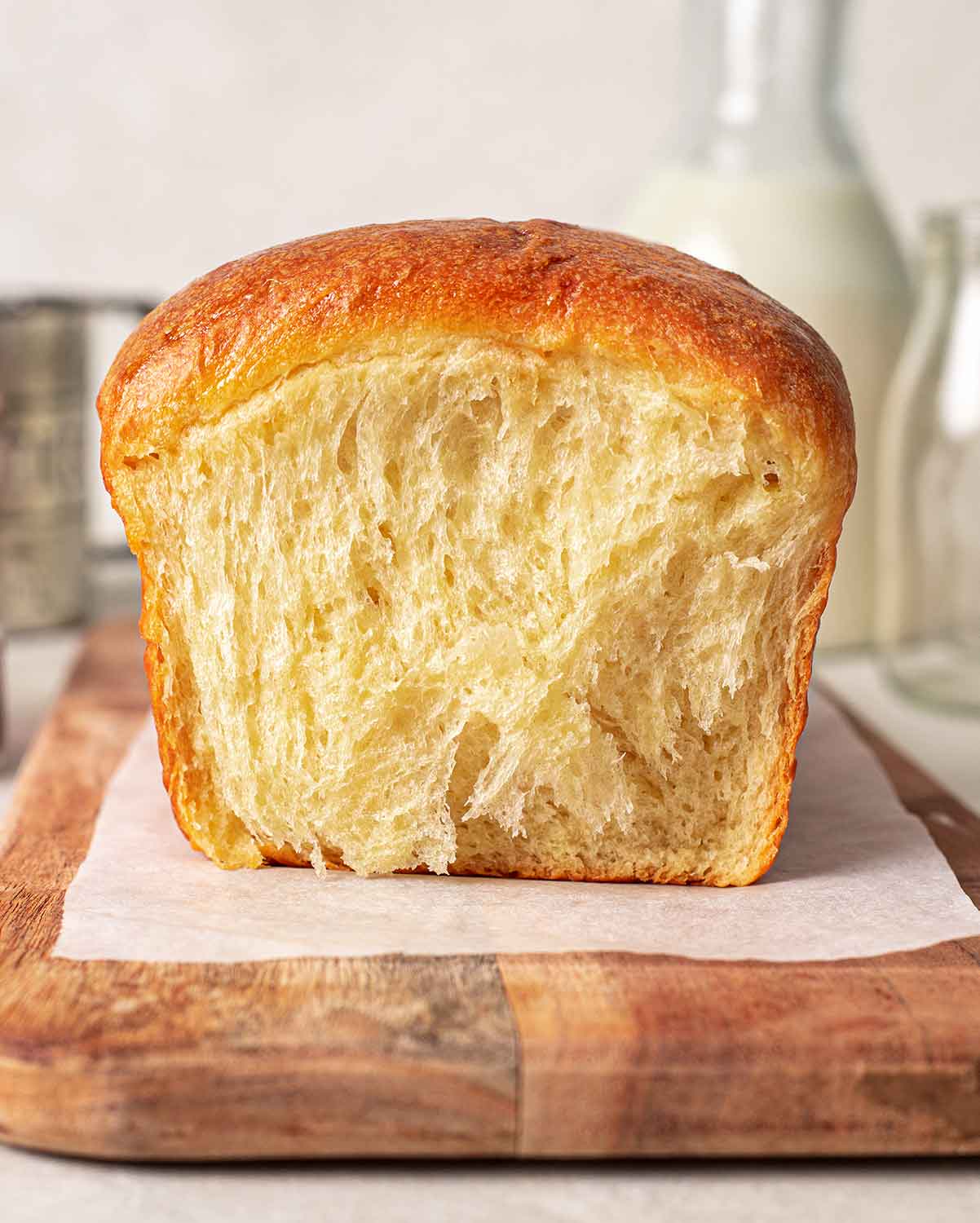
Kneading tips for the fluffiest brioche
Initially, your dough will be sticky but avoid adding more flour. Kneading the dough strengthens its gluten structure and makes it come together in a smoother ball. If your dough is still sticky after 5-10 minutes, you can add more flour.
For the 'advanced kneading method', if your dough is too dry before adding the butter, add a dash of dairy-free milk. The dough may initially resist the butter when you start adding it, but just keep kneading.
The windowpane test is the best way to tell if you've kneaded your dough enough. To do this, grab a small piece of dough and stretch it between your fingers. The dough shouldn't break and you should be able to see its 'gluten membranes'. If the dough breaks, keep kneading.
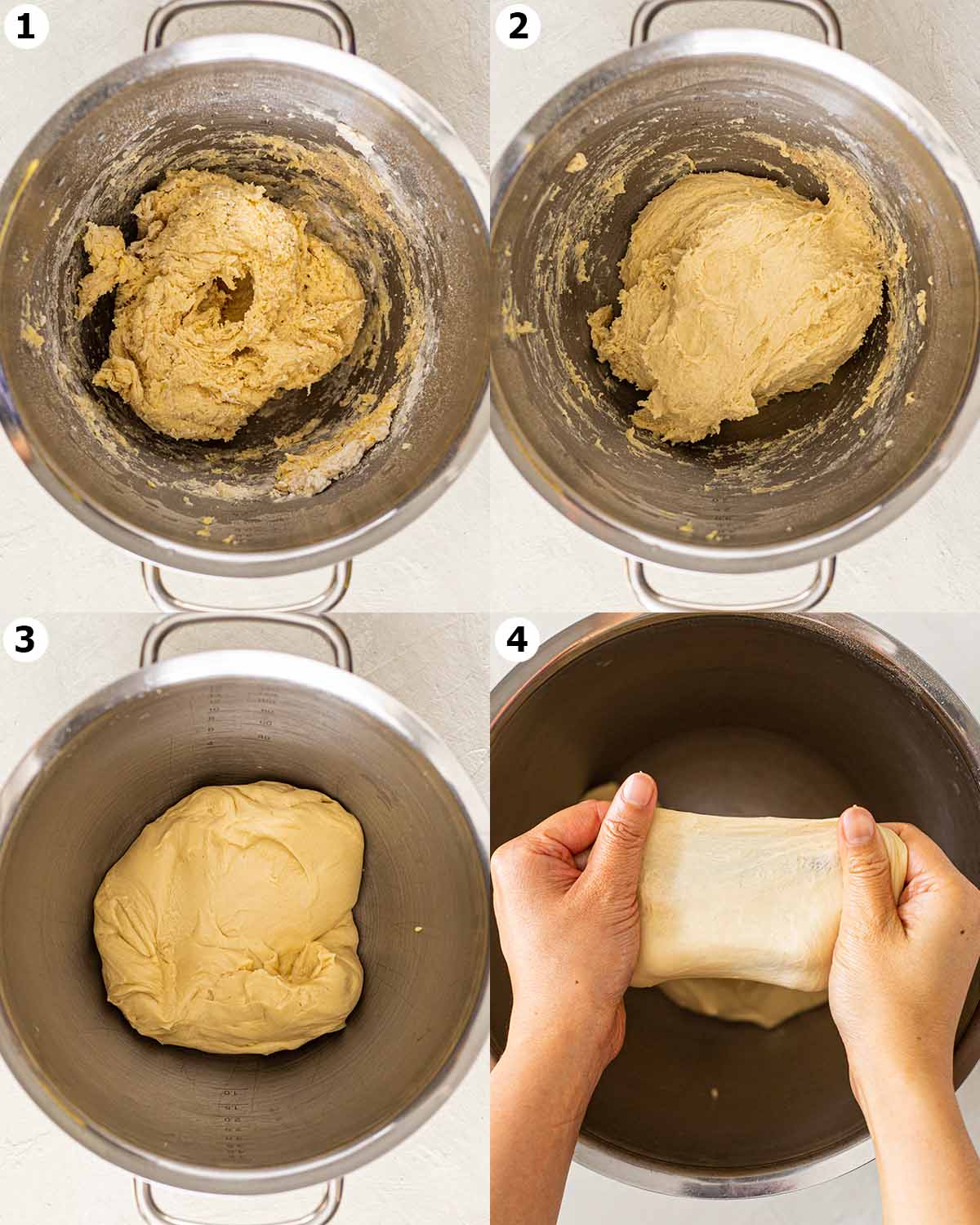
Resting the dough
After kneading the vegan brioche dough, let it rest in a WARM place for 1 hour or until it's doubled. Ideally, it should be somewhere that's around 25°C (77°F). Brioche dough has a lot of butter which can slow down its rise, but if you keep the dough in a warm place, it'll rise more efficiently.
If your dough is taking longer to rise, move it to a warmer spot in your home.
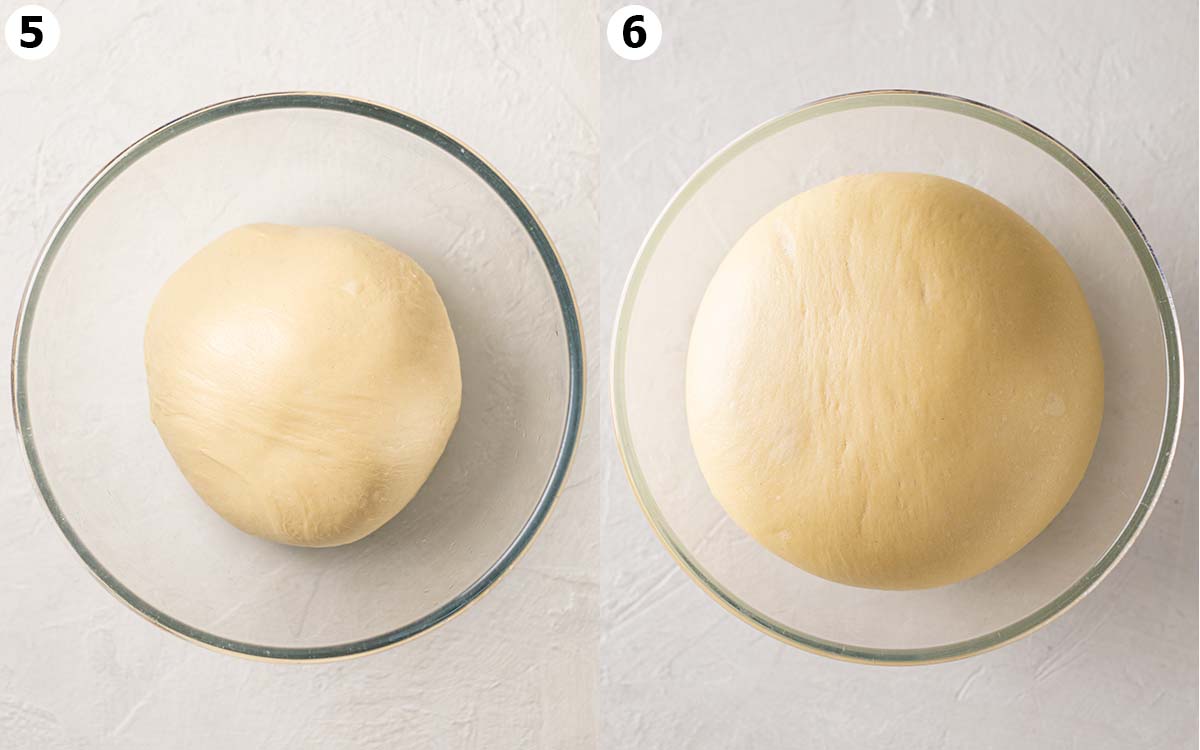
Shaping the brioche and second rise
There are a few ways you can shape vegan brioche. These are just for presentation and don't affect the texture or flavor of the bread:
- As one whole piece. Shape the dough into a large oval shape and place it your loaf pan.
- Divided into 3 to 10 equal pieces and arranged in your loaf pan.
- Braided into challah bread.
If you want to make a fancier shape, check out my cinnamon babka and raspberry jam wreath.
Finally, let your dough rest one more time. It's ready when it grows in size by about 50% and looks puffy. If you poke the surface of the loaf, it should slowly spring back (known as the poke test).
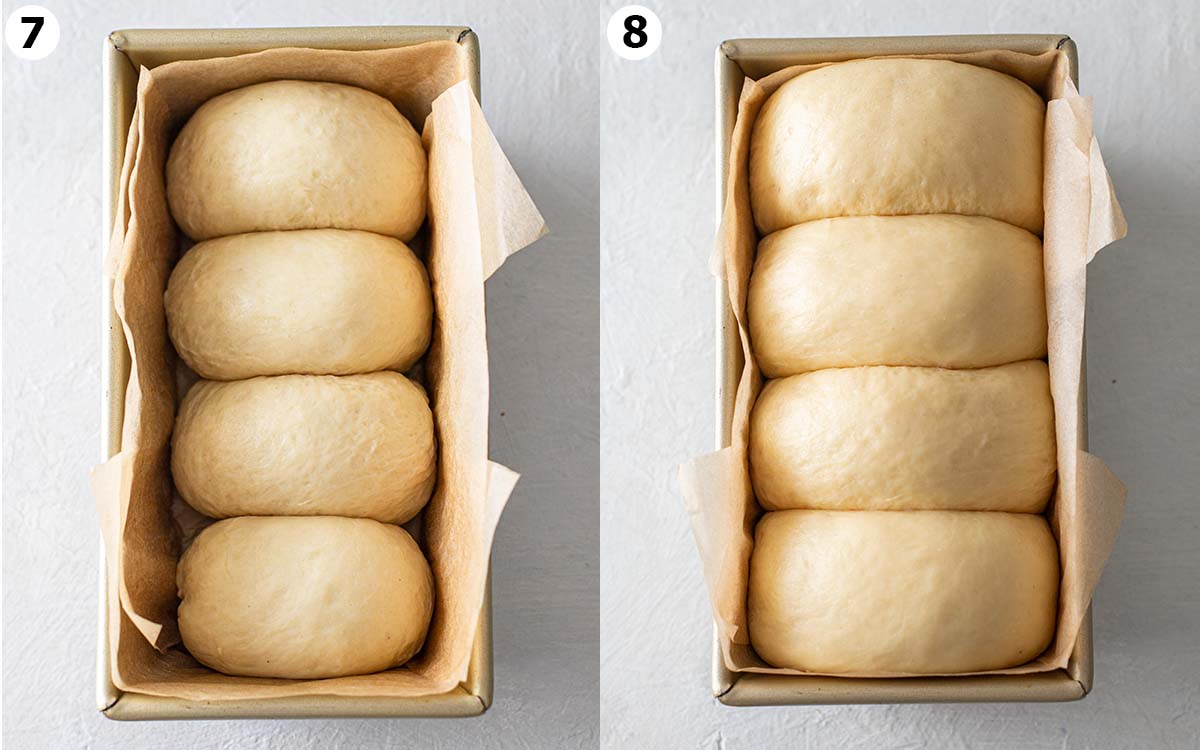
When is my brioche done baking?
Here are a few ways to tell if your vegan brioche is fully baked:
- Remove the hot brioche from the pan and tap the bottom of the loaf. Your brioche will sound hollow when it's baked through.
- Insert a toothpick into the middle, and collect some dough. If the dough is fully cooked, your brioche is ready.
- The top of the brioche should be a deep golden brown.
Instead of using egg wash, brush a little maple syrup on top of the brioche while it's warm. This will give the bread a beautiful golden shine!
See, it is 100% possible to make brioche vegan!
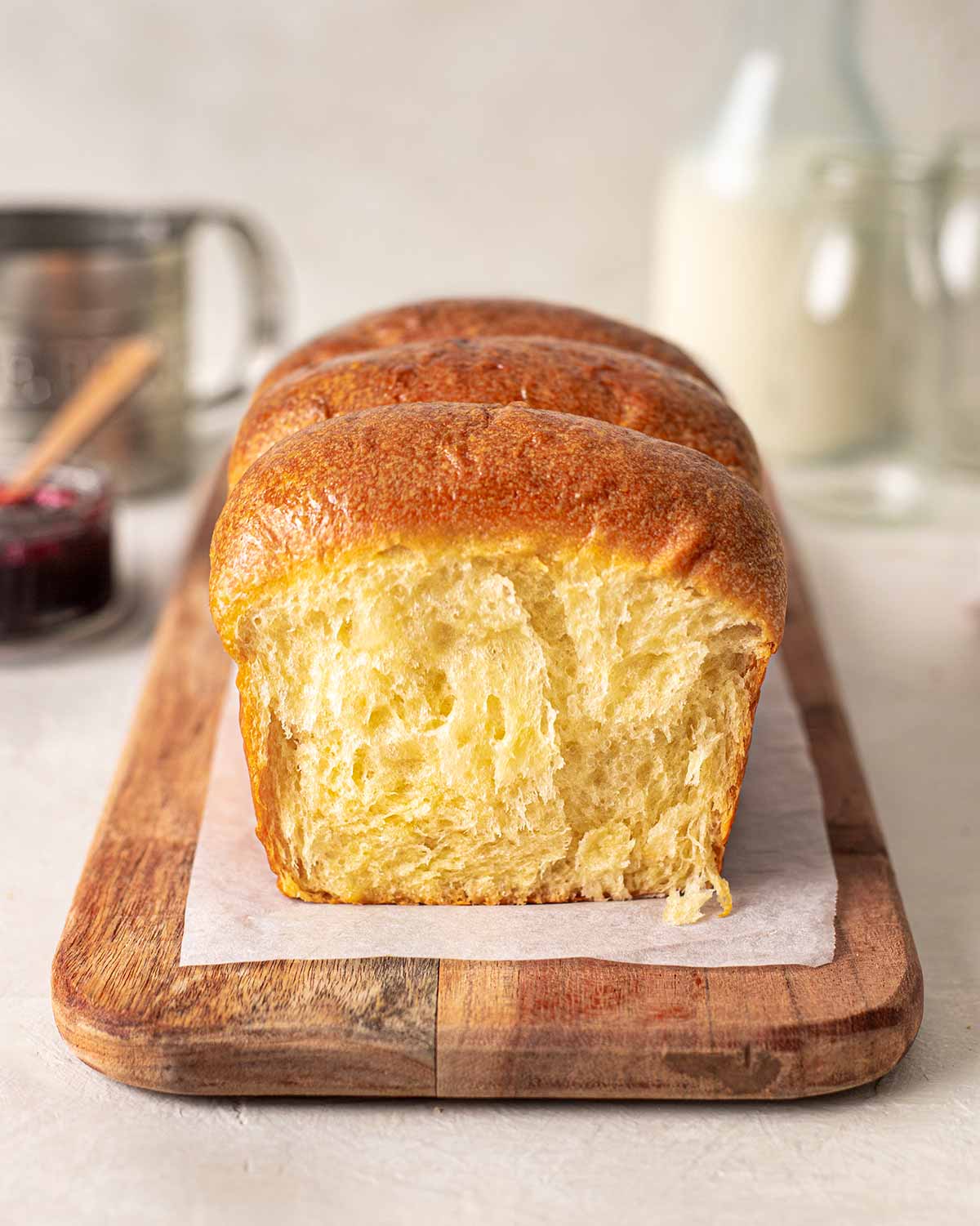
Customizing this recipe
Use whole wheat or spelt flour instead of all-purpose flour for a more wholesome and dense vegan brioche.
Replace vegan butter with extra virgin olive oil for a denser cakey bread.
Use coconut sugar or maple syrup to make this brioche refined sugar-free.
Use a sourdough starter instead of yeast. This recipe works well with 75-150g of an active sourdough starter with 100% hydration. For a stronger sourdough flavor, use more starter. Or make my sourdough cinnamon rolls!
For brioche dinner rolls and burger buns, check out my recipe for vegan brioche buns.
Unfortunately, this recipe won't work with 1:1 gluten-free flour. I am working on a gluten-free version so watch this space!
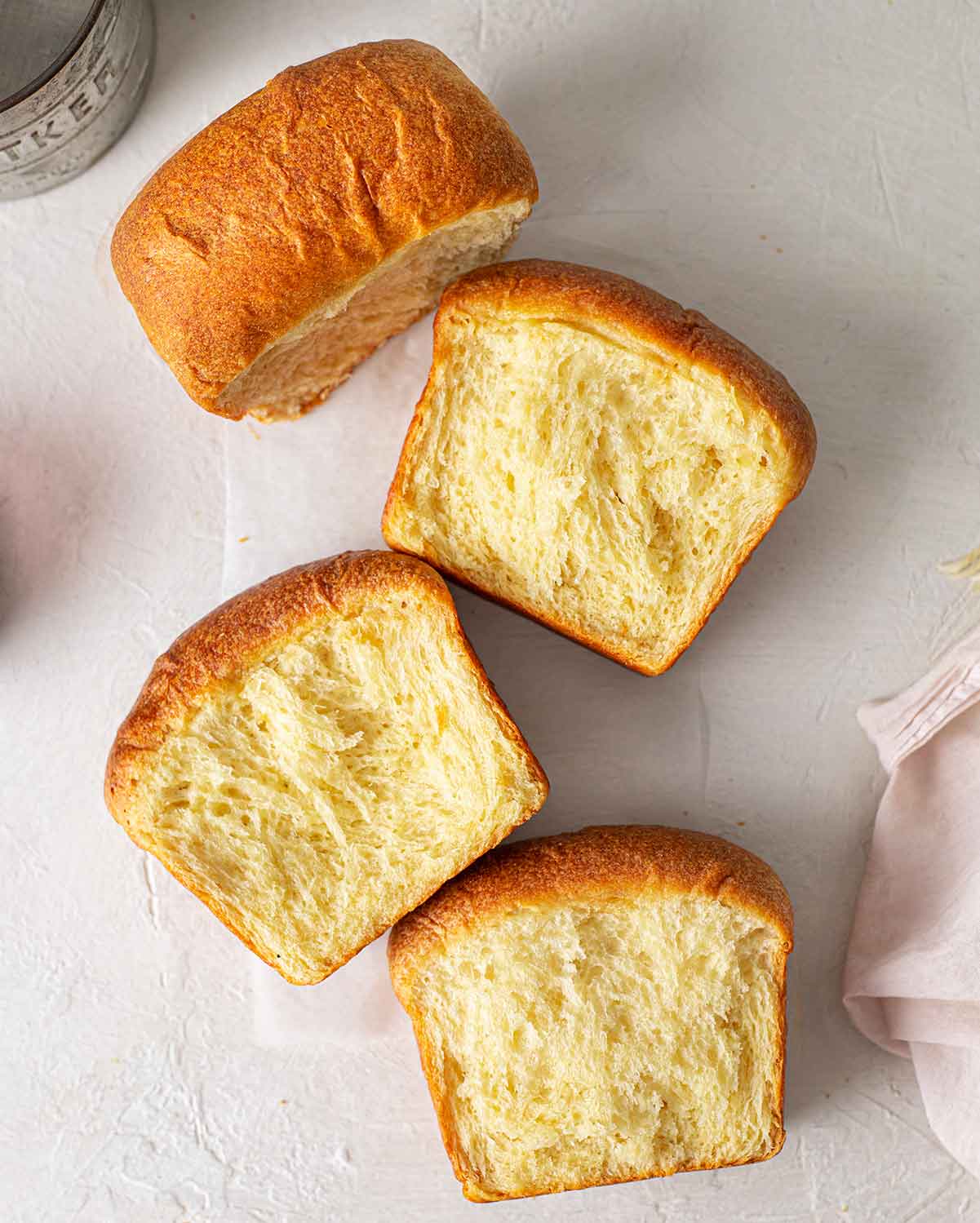
Additional Tips
Yes, prepare the dough and store it in an airtight container in the fridge overnight. The next day, when the dough is not too cold, shape it as desired then let it rest. I don't recommend shaping the brioche and storing it in the fridge because it can overproof which is more difficult to fix.
You can bake the brioche ahead of time. However, it is best enjoyed as close as possible to when it's baked. To refresh the brioche, warm it up in the oven or microwave.
Make sure your dough is resting in a warm spot. Here are some other causes and fixes:
1. Your vegan brioche dough is too dry, maybe from incorrectly measuring the flour. You can still add more dairy-free milk to your dough and knead it in. Make sure your final dough is smooth and stretchy.
2. Your yeast is old and no longer active. Don't worry, this is still fixable! Mix some active yeast with warm milk and a pinch of sugar. Wait until it bubbles then knead the mixture into the dough.
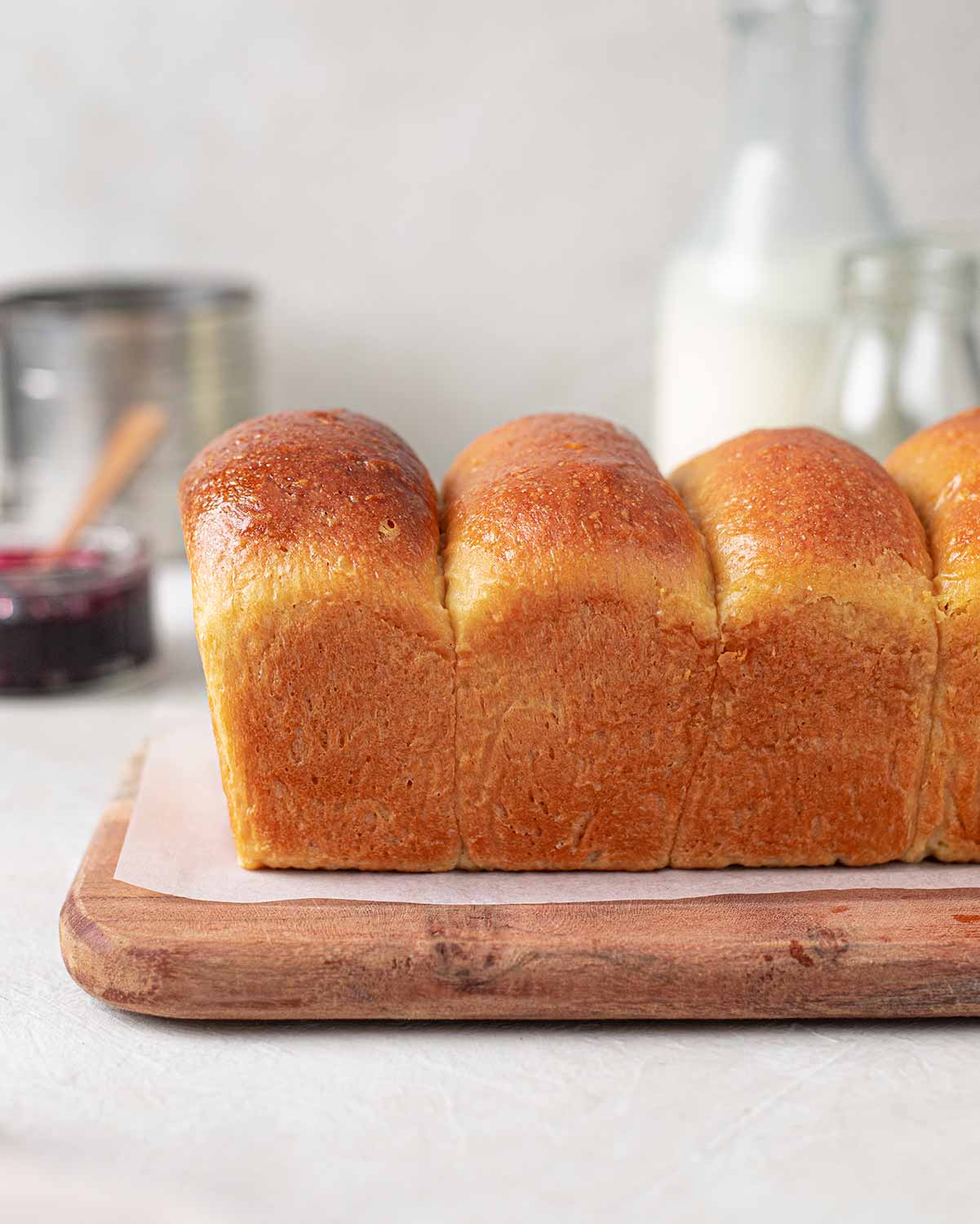
Serving suggestions
This vegan brioche is amazing when it's warm from the oven. However, here are some other ways to enjoy it:
- Toast a slice and serve it with jam, cream, or any sweet spread.
- Use stale leftovers for vegan french toast casserole. You deserve it!
- Crumble the brioche, bake it at low heat and crumble it on ice cream.
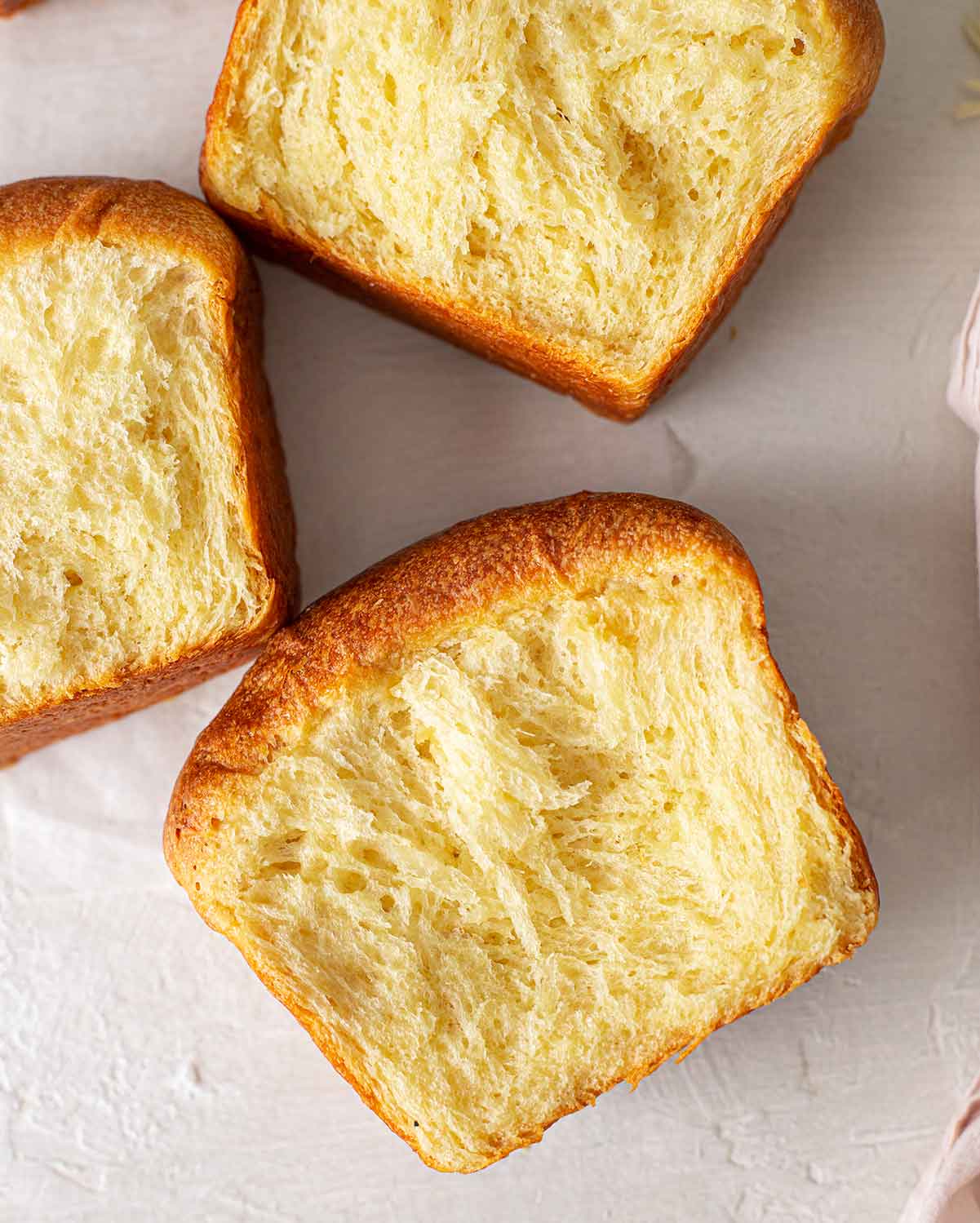
More vegan bread recipes
This brioche recipe is the base for many other bread recipes on my site! My favorites are:
Follow Rainbow Nourishments on Instagram, Facebook, TikTok and Pinterest, and subscribe via email to receive all of our latest recipes!
Buttery Vegan Brioche
Ingredients
Vegan Brioche Bread
- 3 cups (375g) bread flour, or all-purpose plain flour (note 1)
- ¾ cup (190g) dairy-free milk, warm, plus more if needed
- ⅔ cup (150g) vegan butter, room temperature (note 2 for olive oil version)
- ¼ cup (50g) granulated sugar, or coconut sugar
- 1 tablespoon instant dry yeast, (note 3 for active dry yeast)
- 1 teaspoon vanilla extract, optional
- ½ teaspoon salt, if using unsalted butter or oil
To glaze
- 3 tablespoons maple syrup, or any other light-coloured liquid sweetener
Instructions
Knead the dough:
- EASY METHOD: Add all the ingredients (except the maple syrup) to the bowl of a stand mixer with the dough hook attachment. Knead for 10 minutes or until the dough is smooth, soft and elastic. You can also mix the ingredients in a large bowl then knead the dough on a floured surface, but it will take a little longer. The dough is ready when it's smooth and tacky but comes away from the sides of the bowl. If your dough is too dry, add a little more dairy-free milk and knead well.
- ADVANCED METHOD: Add all the ingredients except the butter and maple syrup to a stand mixer with the dough hook. Knead until the mixture is well combined (at least 5 minutes). If your dough isn't coming together, add a little dairy-free milk. While the dough is kneading, gradually add the butter, around 3 tablespoons (40g) at a time. Knead until the dough is very smooth and comes away from the sides of the bowl (at least 15 minutes).
- Place the dough in a clean bowl and cover with a tea towel. Let the dough rest in a WARM spot for at least 1 hour or until it doubles in size (note 4).
Shape the vegan brioche:
- Line an 8-inch (20cm) loaf pan with parchment paper or dust with flour.
- Divide the dough into 4 equal portions, shape each into a ball and arrange them in your loaf pan. Cover the loaf pan with a tea towel and leave it in a warm spot to rest for at least 1 hour. The dough should grow by 50% - 100% and become puffy again.
Bake the vegan brioche:
- When you're ready to bake, preheat the oven to 180°C (350°F).
- Bake the brioche for 30-40 minutes or until the top is deep golden brown. The loaf is fully cooked when you can tap the bottom of the loaf and it sounds hollow. If you poke a skewer in the middle, it shouldn't collect any raw dough. If your brioche is browning too quickly but is not baked through, reduce your oven to 160°C (320°F) and tent the brioche with aluminum foil.
- While the brioche is still hot from the oven, brush the top with maple syrup. Rest the bread in the pan for 15 minutes then transfer it to a wire rack to cool.
- Serve the brioche warm. Store leftovers in an airtight container at room temperature for up to 3 days, in the fridge for 5 days or in the freezer for up to 1 month. Leftover brioche is best enjoyed warmed or toasted.
Notes
- Bread flour gives you a chewier brioche whereas all-purpose flour results in a cake-like brioche. You can use whole wheat flour or white spelt flour, but I suggest adding an extra dash of plant milk.
- Instead of vegan butter, you can use ½ cup (125g) of olive oil. This makes a softer dough and you may need to add a little extra flour. And, don't skip the salt as it mimics a 'buttery' taste.
- Instant yeast doesn't need to be 'proofed' beforehand. If you use active dry yeast, mix it with the warm milk from the recipe and a pinch of sugar in a small bowl beforehand. Wait until it bubbles then use it in the recipe.
- The dough can take anywhere from 1-4 hours to rise, depending on the temperature of your home and your dough. If your dough doesn't grow, place it in a warmer spot in your house. Read my post above for some tips.
Nutrition
This post was originally published in August 2019 and has been updated a few times with an improved recipe that is more similar to traditional French brioche.
This post may contain affiliate links. As an Amazon Associate, I may earn a small commission from qualifying purchases at no additional cost to you.
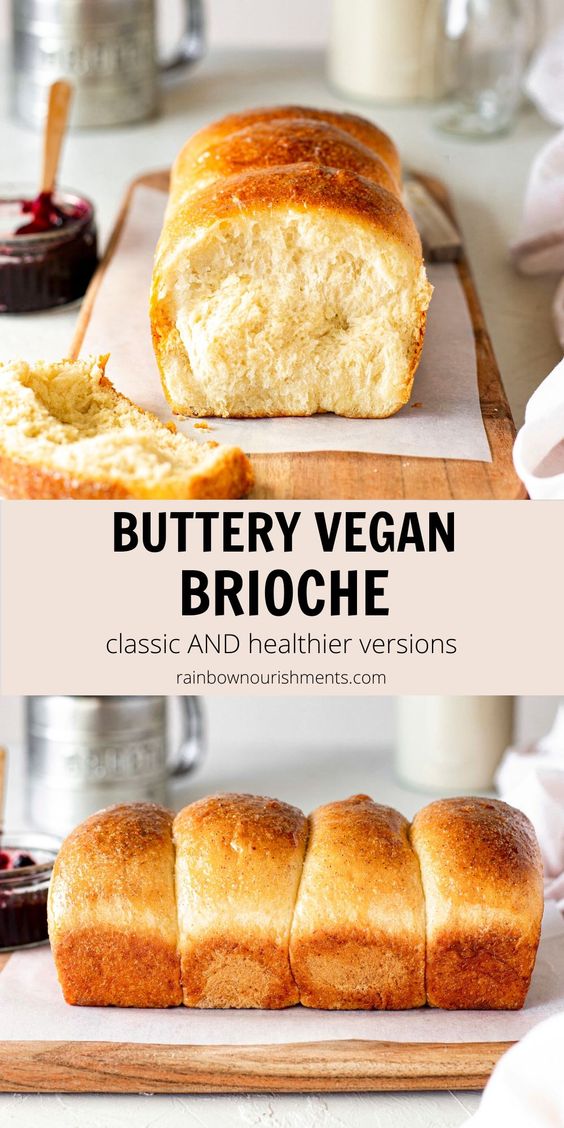


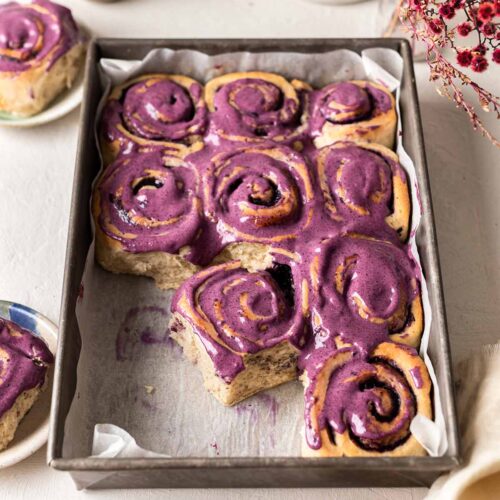
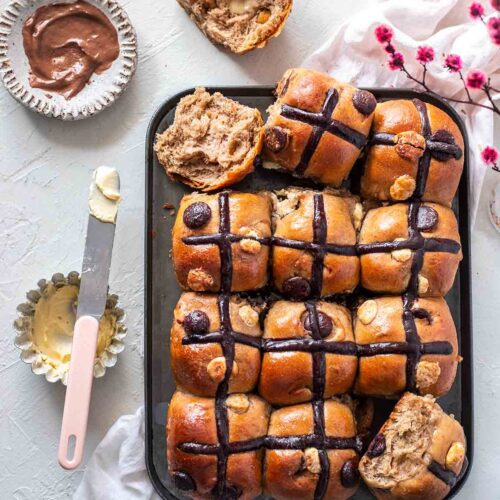
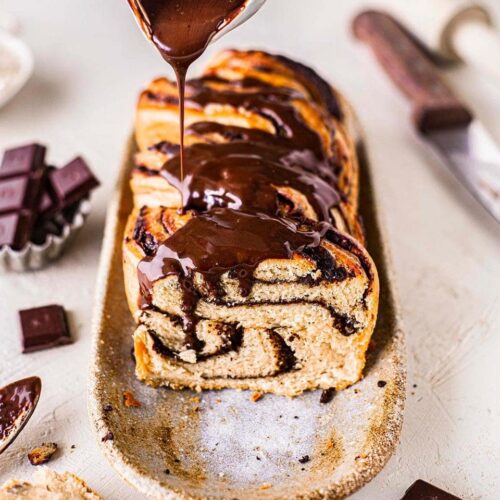
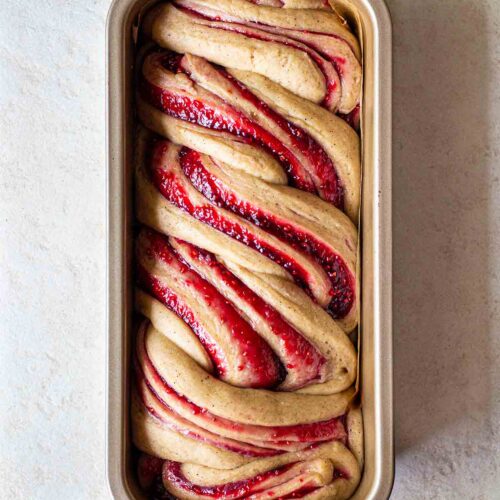
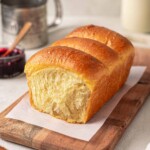
This looks incredible! I read that you were working on a gluten free version, did you find anything that worked? I'm looking for a vegan GF brioche recipe, thank you!
Hi Mei-Ling, thank you! Unfortunately I haven't found any gluten-free flours that live up to the original version of this recipe, sorry!
I have never made bread in my life so I ask this question humbly. 🙂 In another vegan brioche recipe, the instructions include a second kneading before the second rise. Is the second kneading not necessary?
Hi Diane! Personally, I don't think it's necessary to knead the dough twice and I don't do this for any other yeast recipe (such as cinnamon rolls or pizza dough). Some recipes may do this because it knocks out any large air bubbles. However, I find that punching down the dough after the first rise and shaping the dough in the loaf pan helps knock out any large bubbles :). Plus, kneading the dough twice can make it a bit tough which makes it more difficult to shape the bread. I hope that helps!
I’ve made this several times and it is excellent! The only time it hasn’t risen as well was my own fault (possibly too warm milk, not letting yeast do it’s thing long enough, or not kneading it for long enough)… but it still ALWAYS tastes delicious. Thanks for a fabulous recipe!
Hi Natalie, I'm so glad that this recipe is a keeper for you! And thanks for the tips about when the bread hasn't risen for you - I think we've all made little mistakes like that :). Thanks so much for taking the time to leave a comment over here!
This vegan brioche is delicious! We all enjoyed it. I'll definitely make it again 😉
Hi Claire, that makes me so happy to hear!! Thanks so much for your comment 🙂
Hi Anthea! I don't have stand mixer. Do you have any suggestion to make this recipe without one? Thanks in advance.
Hi Angie! You can certainly make this brioche without a stand mixer. Use the 'easy method' of kneading and mix the ingredients in a bowl first then knead the dough by hand - it will just take a little time. I hope that helps :).
This recipe is very well written and easy to follow. The substitutions and troubleshooting tips were very effective and instilled much confidence before and throughout the actual baking attempt. I could not have imagined a better outcome! The loaf was so soft & fluffy. My only problem is that it did not last long at all! Is this recipe scaleable? I would like to make at least 2 loaves at a time.
Hi Alecia, I'm so glad that you enjoyed this recipe and found it approachable! Also yes, you can definitely scale up the recipe. If you hover over the number next to "servings", it'll let you increase the ingredient quantities. With the method, I'd make the dough in one lot and let it rise in one lot. Otherwise, the rest of the recipe will be the same. I hope that helps and thanks so much for your feedback!
Wondering if anyone has used this recipe to make challah? I am going to try it this week! Basically I will divide the dough and braid it before the final rising and bake on a sheet pan.
Hi Joanna, I've had a few readers on Instagram successfully use this to make a smaller challah! I personally have used it to make a braided wreath as well. Hope that helps!
Hi, I made this brioche and the taste and the texture were amazing. My only question is how can I keep the surface of the brioche from wrinkling after baking? Do you have any tips? Thank you 🙈
Hi Van, I'm glad that you enjoyed this brioche! Brioche can become wrinkly as it contains a lot of moisture and collapses a little after it's baked. Otherwise, if you bake the bread for a little longer, there will be less wrinkles. I hope that helps!
Hi Anthea, I'm wondering if you'd be able to provide any directions as to how I can make this recipe ahead of time and let the dough proof overnight in the fridge? Thank you in advance!
Hi Emily, oh of course! There are two ways to make this brioche in advance:
1. Make the dough, place it in an larger airtight container and let it rise in the fridge overnight. The next day, when the dough is not too cold for your hands, shape it into the loaf and let it rise at room temperature.
2. Make the recipe and shape the brioche dough in the loaf pan. Cover it very loosely and let it rise in the fridge overnight. Then bake it straight from the fridge.
I prefer doing the first method as it's easier to chill the dough when it's unshaped! I hope that helps 🙂
Is there a specific butter brand you recommend?
Hi Anna, it depends where you're based but I love Naturli's block butter. However, any firm vegan butter will work well with this recipe.
This was absolutely amazing, thank you so much for the recipe! I made it 3x in one week and then for my birthday the next week - delicious! It takes me 45 minutes to knead it by hand, and my arms have never been stronger
Now that I've read that this is a master dough, I'm really looking I to converting one of the rolls into a savory situation. Most likely cheese, pesto, and gomashio or everything bagel seasoning. I was just going to follow this recipe and then roll it out but I noticed that the percentages for your rolls are different from the master dough. Should I just follow the rolls (sans cinnamon and maybe reduced sugar) recipe? Or would I be okay just following this? If you're able to share, would love to know the reasoning behind the difference in ratios too! Thanks so much, Anthea!
Hey! This brioche dough is great for shaping into rolls and would be wonderful with cheese, pesto or anything savory. My cinnamon roll recipes have slightly different ratios because the dough needs to be firmer for rolling and cutting. Cinnamon rolls also have added frosting/filling so the plain dough doesn't need as much butter. I hope that helps!
Omg! I been down with a flu and was craving the flavors of home (grew up in a bakery). This did it. I had all the ingredients took less than 2 hours and it was perfect. I will treasure this recipe for years to come 💘
I'm sooo happy that you loved brioche and that it brought some nostalgia to help with your flu! I'm in the same boat and may just make this brioche too, haha. Thank you so much Alma and I hope you heal soon x
This recipe tastes like Hong Kong Pai Bao or Hokkaido milk bread, But without the fuss of tangzhong. I love how simple it is and it turns out very well every time. I used the advanced method and it was still more easier to put together than making pai bao. I taught my 10 and 13 yr old the recipe and they love making them.
Thanks so much for sharing the recipe!
I have made this bread four times now, once made them into buns for a BBQ. always tasty, and always successful thank you for posting this recipie
Wow, four times, you're amazing! I'm so glad you've enjoy this brioche and that it worked well as buns for you :).
I have made this recipe over 20 times and love it so much! I want to make four mini loaves instead (the pans' exact size is 5.75” x 3”). Do you know if this would affect the baking time?
Aw that's the best thing I've heard today!! I'm so glad you've enjoyed this brioche so much :). Also yes, definitely reduce the baking time with your mini loaves. I'd say check them at around 20 minutes and bake them until the top is golden brown. I hope that helps!